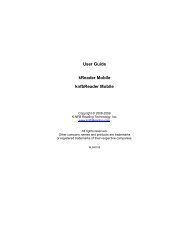User Guide kReader Mobile knfbReader Mobile
User Guide kReader Mobile knfbReader Mobile
User Guide kReader Mobile knfbReader Mobile
Create successful ePaper yourself
Turn your PDF publications into a flip-book with our unique Google optimized e-Paper software.
SECTION 1. LEARNING THE POWER OF YOUR READER<br />
Welcome to the world of mobile text recognition and reading through our growing <strong>Mobile</strong> Reader family of<br />
innovative, life-changing products. This <strong>Guide</strong> will help you learn to use the <strong>kReader</strong> <strong>Mobile</strong>, and the<br />
<strong>knfbReader</strong> <strong>Mobile</strong> which is designed for blind users.<br />
The <strong>Mobile</strong> Reader will enable you to read most ordinary printed documents within only a few seconds<br />
after taking a picture. "<strong>Mobile</strong>" means reading on the go. So, don't leave home without your <strong>Mobile</strong><br />
Reader. Take it and use it anywhere you go.<br />
1.1 What the Reader Can Do<br />
The <strong>Mobile</strong> Reader - or simply, Reader - can read a wide variety of document types you may encounter<br />
throughout the day. It performs particularly well for reading printed memos, reports, fliers, and virtually<br />
any other kind of document typically printed from a personal computer. It will also read many<br />
professionally printed items of various sizes, colors, and styles, including:<br />
• books<br />
• magazines<br />
• most restaurant menus<br />
• utility bills<br />
• printed mailing addresses<br />
• class or conference handouts<br />
• hotel bills<br />
• printed receipts<br />
• business cards<br />
• airline boarding passes<br />
• labels on packaged foods showing contents and nutrition information<br />
• transit brochures and schedules<br />
• CD labels<br />
1.2 What the Reader Cannot Do<br />
The Reader is programmed to recognize and respond to a wide variety of type styles, printing formats,<br />
and lighting conditions. However, as computer software, your Reader is not quite as adaptable as the<br />
human brain. You can expect some printed matter to be read accurately with very high reliability, but in<br />
other instances the accuracy may be less than you would like. In general you should give the Reader a<br />
try with things you need to read. This will help you to learn best what to expect.<br />
The Reader is not designed for use with handwriting or scrolling text on a screen or sign. Accuracy for<br />
household product containers (food boxes, tea bags, milk containers, detergent bottles, etc.) may vary,<br />
especially if the written information on these containers is artistically presented or is surrounded by<br />
pictures and graphics. Other circumstances that may lower accuracy include:<br />
• text printed on cylinders with warped or incomplete images (such as soup cans or medicine<br />
bottles)<br />
• LED and LCD screens (such as digital clocks, computer screens, and cell phone screens)<br />
• vending machine buttons and instructions<br />
• engraved print (such as serial numbers) on machines<br />
• very large printed text<br />
Page 4




